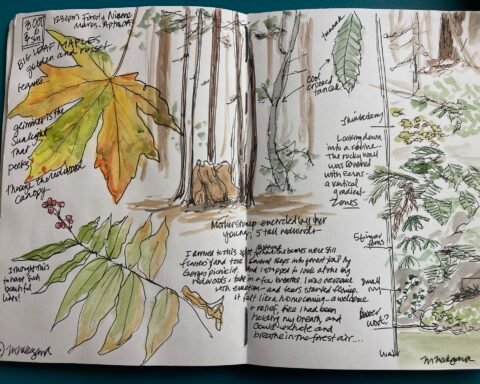As the chill of winter melts away and the earth awakens, spring emerges as a vibrant reminder of renewal and growth. The season beckons us outdoors, encouraging a reconnection with nature that can have profound benefits for our physical and mental well-being. Amid the cacophony of modern life, cultivating a practice that intertwines meditation with the natural world can foster a deeper understanding of ourselves and the environment around us.
The Science of Nature and Well-Being
Research continues to substantiate the age-old adage that nature heals. Studies have shown that spending time in natural environments can reduce stress, decrease anxiety, and enhance overall emotional health. According to a meta-analysis by Barton and pretty (2010), nature exposure is linked to various mental health benefits, such as improved mood and reduced feelings of tension (Barton, J., & Pretty, J. (2010). What is the best way to encourage people to engage with nature? A review of the evidence. Journal of Environmental Psychology, 30(3), 203-211).
Integrating meditative practices into this connection creates a powerful synergy, offering both stillness and an opportunity to absorb the changing landscapes through mindfulness. As spring brings with it blooming flowers, singing birds, and the fresh scent of earth, it opens a unique window to explore meditative practices that encourage mindfulness and reflection.
Meditative Practices to Embrace This Spring
1. Mindful Walking
Walking through a park or forest can transform into a meditative practice by focusing your attention fully on the act itself. Jon Kabat-Zinn, the renowned mindfulness expert, emphasizes the importance of being fully present in our bodies during activities like walking (Kabat-Zinn, J. (2005). Wherever You Go, There You Are: Mindfulness Meditation in Everyday Life. Hachette Books).
Pick a natural setting that resonates with you—a local botanical garden, a winding trail, or even your neighborhood. As you walk, let your senses awaken; notice the colors of the blossoms, the sounds of rustling leaves, and the scent of fresh blooms. This practice encourages awareness of both your body and your surroundings while fostering a sense of gratitude for the beauty of nature.
2. Nature Journaling
A simple notebook and a pencil can transform your outdoor experiences into a rich tapestry of observations and insights. Nature journaling involves more than writing; it invites participants to sketch, paint, or otherwise express their impressions of the world around them.
Author Clare Walker Leslie highlights the importance of observation in her book, Keeping a Nature Journal (Leslie, C.W., & Roth, A. (2003). Keeping a Nature Journal: Discover a Whole New Way of Seeing the World Around You. Storey Publishing).
Find a comfortable spot to sit and observe. Take note of the sights, sounds, and smells that fill your surroundings. Draw what you see—a budding flower or a soaring bird. Reflect on how these observations make you feel. This practice not only enhances your connection to nature but also allows for creativity to flourish, acting as a bridge between the mind, body, and earth.
3. Guided Meditation in Nature
Embrace the warmth and gentle energy of spring through guided meditations that focus on natural themes. Many wellness centers and online platforms offer resources designed for outdoor meditation, leading participants through visualizations that incorporate the essence of spring—growth, blooming, and renewal.
Find a quiet place to settle with your senses open. According to Thich Nhat Hanh, a prominent Zen master, mindfulness can be cultivated through awareness and presence in nature (Hanh, T.N. (2015). The Art of Communicating. HarperCollins). Listen to the gentle calls of birds, the whispers of the wind, and the rustle of leaves. Allow these sounds to draw your awareness to the present moment, inviting a deeper connection to the life unfolding around you. Visualize yourself as part of this ecosystem, breathing in sync with the richness of life surrounding you.
4. Gardening as Meditation
Engaging with the soil can be profoundly meditative, offering a tactile experience that fosters mindfulness. Spring invites us to plant seeds and nurture growth, turning gardening into an act of intention and care—both for the plants and for ourselves.
Garden Therapy, as outlined in Therapeutic Landscapes by Francine C. C. Rudder and Gary J. L. McDonald, demonstrates how gardening can improve emotional well-being—stimulating creativity, promoting relaxation, and enhancing our sense of connection to the earth (Rudder, F.C.C., & McDonald, G.J.L. (2010). Therapeutic Landscapes: Healing Spaces in an Urbanized World. Springer).
Whether you’re tending to a backyard, balcony, or community garden, immerse yourself in the process. Dig your hands into the earth, feel the texture of soil, and plant with purpose. Observe the growth cycle and reflect on the care your plants require, drawing parallels to the nurturing required for your own well-being and emotional growth.
5. Nature Bathing (Shinrin-Yoku)
Originating from Japan, shinrin-yoku, or “forest bathing,” encourages individuals to immerse themselves in a forest environment, promoting a deep connection with nature. According to Miyazaki and Tsunetsugu (2010), forest bathing has been shown to lower cortisol levels and enhance immune function (Miyazaki, Y., & Tsunetsugu, Y. (2010). Health Benefits of the Japanese “Shinrin-yoku” (Forest Air Bathing) and Its Physiological Effects. International Journal of Environmental Research and Public Health, 7(10), 490-500).
This practice emphasizes sensory engagement—taking slow walks, breathing in the fresh air, and allowing yourself to be enveloped by the sounds, sights, and smells of the forest.
As you move at a gentle pace, take time to touch the rough bark of a tree, listen to the rustling leaves, and breathe in the scent of blooming flowers. Shinrin-yoku is about absorbing nature’s tranquility and embracing the healing energy surrounding you. This deep sensory immersion can be both grounding and restorative, offering a reprieve from the demands of daily life.
The Power of Connection
As we transition into the warmth and liveliness of spring, the opportunity to reconnect with nature through meditation is more vital than ever. By integrating these practices, we invite calmness into our busy lives while fostering a deepened sense of awareness—not only of ourselves but also of our intricate relationship with the world around us.
In an era defined by screen time and urban living, spring serves as a timely reminder of the beauty that the natural world offers. By stepping outside and immersing ourselves in the rich tapestry of seasonal change, we discover the powerful interplay between nature and our own well-being, creating a holistic approach to healing that can enrich our lives.
So, as the flowers bloom and nature awakens, consider how you might weave moments of mindfulness and connection into your days. Embrace the spirit of spring, allowing its vibrancy to inspire a more profound relationship with both the earth and yourself.
References
- Barton, J., & Pretty, J. (2010). What is the best way to encourage people to engage with nature? A review of the evidence. Journal of Environmental Psychology, 30(3), 203-211.
- Kabat-Zinn, J. (2005). Wherever You Go, There You Are: Mindfulness Meditation in Everyday Life. Hachette Books.
- Leslie, C.W., & Roth, A. (2003). Keeping a Nature Journal: Discover a Whole New Way of Seeing the World Around You. Storey Publishing.
- Hanh, T.N. (2015). The Art of Communicating. HarperCollins.
- Rudder, F.C.C., & McDonald, G.J.L. (2010). Therapeutic Landscapes: Healing Spaces in an Urbanized World. Springer.
- Miyazaki, Y., & Tsunetsugu, Y. (2010). Health Benefits of the Japanese “Shinrin-yoku” (Forest Air Bathing) and Its Physiological Effects. International Journal of Environmental Research and Public Health, 7(10), 490-500.
















